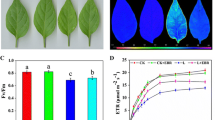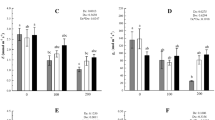Abstract
The effects of 24-epibrassinolide under high temperature in eggplant (Solanum melongena L.) seedlings were studied by investigating the plant growth, chlorophyll content, photosynthesis and antioxidant systems. High temperature significantly inhibited the plant growth and markedly decreased the chlorophyll content, net photosynthetic rate, stomatal conductance and transpiration rate, while it increased intercellular CO2 concentration. In a similar manner, high temperature also decreased significantly maximum quantum efficiency of PSII, potential photochemical efficiency, the quantum efficiency of PSII, photochemical quenching, the excitation capture efficiency of open centers, and increased non-photochemical quenching. Application of 0.05–0.2 μM EBR remarkably promoted the plant growth and alleviated high-temperature-induced inhibition of photosynthesis. Under high temperature, reactive oxygen species levels and lipid peroxidation were markedly increased, which were remarkably inhibited by application of 0.05–0.2 μM EBR. The activities of antioxidative enzymes such as superoxide dismutase, peroxidase, catalase and ascorbate peroxidase, and contents of ascorbic acid and reduced glutathione were significantly increased during high-temperature treatments, and these increases were more pronounced than those of EBR at 0.05–0.2 μM treatment. The EBR treatment also greatly enhanced contents of proline, soluble sugar and protein under high-temperature stress. Taken together, it can be concluded that 0.05–0.2 μM EBR could alleviate the detrimental effects of high temperatures on plant growth by increasing photosynthetic efficiency and enhancing antioxidant enzyme systems. Addition of 0.1 μM EBR had the best ameliorative effect against high temperature, while the addition of 0.4 μM EBR had no significant effects.







Similar content being viewed by others
Abbreviations
- AsA:
-
Ascorbic acid
- BRs:
-
Brassinosteroids
- CAT:
-
Catalase
- Chl:
-
Chlorophyll
- C i :
-
Intercellular CO2 concentration
- E :
-
Transpiration rate
- EBR:
-
24-Epibrassinolide
- Fm:
-
Maximal fluorescence
- Fo:
-
Minimal fluorescence
- Fv/Fm:
-
Maximal quantum efficiency of PSII
- Fv′/Fm′:
-
The excitation capture efficiency of open centers
- Fv/Fo:
-
Potential photochemical efficiency of PSII
- g s :
-
Stomatal conductance
- GSH:
-
Reduced glutathione
- MDA:
-
Malondialdehyde
- NBT:
-
Nitroblue tetrazolium
- NPQ:
-
Non-photochemical quenching
- P N :
-
Net photosynthetic rate
- PSII:
-
Photosystem II
- ΦPSII:
-
Quantum efficiency of PSII
- O ·–2 :
-
Superoxide radical
- POD:
-
Peroxidase
- qp :
-
Photochemical quenching
- ROS:
-
Reactive oxygen species
- SOD:
-
Superoxide dismutase
References
Allakhverdiev SI, Kreslavski VD, Klimov VV, Los DA, Carpentier R, Mohanty P (2008) Heat stress: an overview of molecular responses in photosynthesis. Photosynth Res 98:541–550
Almeselmani M, Deshmukh PS, Sairam RK, Kushwaha SR, Singh TP (2006) Protective role of antioxidant enzymes under high temperature stress. Plant Sci 171:382–388
Andre CM, Yvan L, Daniele E (2010) Dietary antioxidants and oxidative stress from a human and plant perspective: a review. Curr Nutr Food Sci 6:2–12
Apel K, Hirt H (2004) Reactive oxygen species: metabolism, oxidative stress and signal transduction. Ann Rev Plant Biol 55:373–399
Arakawa N, Tsutsumi K, Sanceda NG, Kurata T, Inagaki C (1981) A rapid and sensitive method for the determination of ascorbic acid using 4,7-diphenyl-1,10-phenanthroline. Agric Biol Chem 45:1289–1290
Asthir B, Koundal A, Bains NS (2012) Putrescine modulates antioxidant defense response in wheat under high temperature stress. Biol Plant 56:757–761
Bajguz A (2000) Effect of brassinosteroids on nucleic acids and protein content in cultured cells of Chlorella vulgaris. Plant Physiol Biochem 38:209–215
Bajguz A, Hayat S (2009) Effects of brassinosteroids on the plant responses to environmental stresses. Plant Physiol Biochem 47:1–8
Barbafieri M, Tassi E (2011) Brassinosteroids for phytoremediation application. In: Hayat S, Ahmad A (eds) Brassinosteroids: a class of plant hormone. Springer, The Netherlands, pp 403–437
Bartwal A, Mall R, Lohani P, Guru SK, Arora S (2012) Role of secondary metabolites and brassinosteroids in plant defense against environmental stresses. J Plant Growth Regul 32:216–232
Bates LS, Waldren RP, Teare ID (1973) Rapid determination of free proline for water-stress studies. Plant Soil 39:205–207
Berry JA, Björkman O (1980) Photosynthetic response and adaptation to temperature in higher plants. Ann Rev Plant Physiol 31:491–543
Bradford MM (1976) A rapid and sensitive method for the quantitation of microgram quantities of protein utilizing the principle of protein–dye binding. Anal Biochem 72:248–254
Buysse J, Merckx R (1993) An improved colorimetric method to quantify sugar content of plant tissue. J Exp Bot 44:1627–1629
Cao YY, Zhao H (2008) Protective roles of brassinolide on rice seedlings under high temperature stress. Rice Sci 15:63–68
Cao S, Xu Q, Cao Y, Qian K, An K, Zhu Y, Binzeng H, Zhao H, Kuai B (2005) Loss of function mutations in DET2 gene lead to an enhanced resistance to oxidative stress in Arabidopsis. Physiol Plant 123:57–66
Dhaubhadel S, Browning KS, Gallie DR, Krishna P (2002) Brassinosteroid functions to protect the translational machinery and heat-shock protein synthesis following thermal stress. Plant J 29:681–691
Divi UK, Krishna P (2009) Brassinosteroid: a biotechnological target for enhancing crop yield and stress tolerance. New Biotechnol 26:131–136
Durner J, Klessing DF (1996) Salicylic acid is a modulator of tobacco and mammalian catalases. J Biol Chem 271:28492–28502
El-Bassiony AM, Ghoname AAA, El-Awadi ME, Fawzy ZF, Gruda N (2012) Ameliorative effects of brassinosteroids on growth and productivity of snap beans grown under high temperature. Gesunde Pflanzen 64:175–182
Elsheery NI, Cao KF (2008) Gas exchange, chlorophyll fluorescence, and osmotic adjustment in two mango cultivars under drought stress. Acta Physiol Plant 30:769–777
Garg N, Chandel S (2012) Role of arbuscular mycorrhizal (AM) fungi on growth, cadmium uptake, osmolyte, and phytochelatin synthesis in Cajanus cajan (L.) Millsp. under NaCl and Cd stresses. J Plant Growth Regul 31:292–308
Genty B, Briantais JM, Baker NR (1989) The relationships between the quantum yield of photosynthetic electron transport and quenching of chlorophyll fluorescence. Biochim Biophys Acta 990:87–92
Giannopolitis CN, Ries SK (1977) Superoxide dismutases. I. Occurrence in higher plants. Plant Physiol 59:309–314
Griffiths OW (1980) Determination of glutathione and glutathione disulphide using glutathione reductase and 2-vinylpyridine. Anal Biochem 106:207–212
Guo FX, Zhang MX, Chen Y, Zhang WH, Xu SJ, Wang JH, An LZ (2006) Relation of several antioxidant enzymes to rapid freezing resistance in suspension cultured cells from alpine Chorispora bungeana. Cryobiology 52:241–250
Hammerschmidt R, Nuckles EM, Kuc J (1982) Association of enhanced peroxidase activity with induced systemic resistance of cucumber to Colletotrchum lagenarium. Physiol Plant Pathol 20:73–82
Hu WH, Xiao YA, Zeng JJ, Hu XH (2010) Photosynthesis, respiration and antioxidant enzymes in pepper leaves under drought and heat stresses. Biol Plant 54:761–765
Janeczko A, Oklestkova J, Pociecha E, Koscielniak J, Mirek M (2011) Physiological effects and transport of 24-epibrassinolide in heat-stressed barley. Acta Physiol Plant 33:1249–1259
Knudson LL, Tibbitts TW, Edwards GE (1977) Measurement of ozone injury by determination of leaf chlorophyll concentration. Plant Physiol 60:606–608
Li YH, Liu YJ, Xu XL, Jin M, An LZ, Zhang H (2012) Effect of 24-epibrassinolide on drought stress-induced changes in Chorispora bungeana. Biol Plant 56:192–196
Liu YJ, Zhao ZG, Si J, Di CX, Han J, An LZ (2009) Brassinosteroids alleviate chilling-induced oxidative damage by enhancing antioxidant defense system in suspension cultured cells of Chorispora bungeana. Plant Growth Regul 59:207–214
Liu ZX, Bie ZL, Huang Y, Zhen A, Lei B, Zhang HY (2012) Grafting onto Cucurbita moschata rootstock alleviates salt stress in cucumber plants by delaying photoinhibition. Photosynthetica 50:152–160
Mazorra LM, Holton N, Bishop GJ, Núñez M (2011) Heat shock response in tomato brassinosteroid mutants indicates that thermotolerance is independent of brassinosteroid homeostasis. Plant Physiol Biochem 49:1420–1428
Mittler R (2002) Oxidative stress antioxidants and stress tolerance. Trends Plant Sci 7:405–410
Nakano Y, Asada K (1981) Hydrogen peroxide is scavenged by ascorbate-specific peroxidase in spinach chloroplasts. Plant Cell Physiol 22:867–880
Neves JPC, Ferreira LFP, Vaz MM, Gazarini LC (2008) Gas exchange in the salt marsh species Atriplex portulacoides L. and Limoniastrum monopetalum L. in Southern Portugal. Acta Physiol Plant 30:91–97
Ogweno JO, Song XS, Shi K, Hu WH, Mao WH, Zhou YH, Yu JQ, Nogues S (2008) Brassinosteroids alleviate heat-induced inhibition of photosynthesis by increasing carboxylation efficiency and enhancing antioxidant systems in Lycopersicon esculentum. J Plant Growth Regul 27:49–57
Patterson BD, Mackae EA, Mackae I (1984) Estimation of hydrogen peroxide in plants extracts using titanium (IV). Anal Biochem 139:487–492
Peleg Z, Blumwald E (2011) Hormone balance and abiotic stress tolerance in crop plants. Curr Opin Plant Biol 14:290–295
Sharkey TD, Zhang R (2010) High temperature effects on electron and proton circuits of photosynthesis. J Integr Plant Biol 52:712–722
Suleman P, Redha A, Afzal M, Al-Hasan R (2012) Temperature-induced changes of malondialdehyde, heat-shock proteins in relation to chlorophyll fluorescence and photosynthesis in Conocarpus lancifolius. Acta Physiol Plant 28:1–9
Talaat NB, Shawky BT (2013) 24-Epibrassinolide alleviates salt-induced inhibition of productivity by increasing nutrients and compatible solutes accumulation and enhancing antioxidant system in wheat (Triticum aestivum L.). Acta Physiol Plant 35:729–740
Vriet C, Russinova E, Reuzeau C (2012) Boosting crop yields with plant steroids. Plant Cell 24:842–857
Wahid A, Gelani AM, Foolad MR (2007) Heat tolerance in plants: an overview. Environ Exp Bot 61:199–223
Xia XJ, Huang LF, Zhou YH, Mao WH, Shi K, Wu JX, Asami T, Chen ZX, Yu JQ (2009) Brassinosteroids promote photosynthesis and growth by enhancing activation of Rubisco and expression of photosynthetic genes in Cucumis sativus. Planta 230:1185–1196
Yang W, Sun Y, Chen S, Jiang J, Chen F, Fang W, Liu Z (2011) The effect of exogenously applied nitric oxide on photosynthesis and antioxidant activity in heat stressed chrysanthemum. Biol Plant 55:737–740
Yin H, Chen QM, Yi MF (2008) Effects of short-term heat stress on oxidative damage and responses of antioxidant system in Lilium longiflorum. Plant Growth Regul 54:45–54
Yu JQ, Huang LF, Hu WH, Zhou YH, Mao WH, Ye SF, Nogues S (2004) A role for brassinosteroids in the regulation of photosynthesis in Cucumis sativus. J Exp Bot 55:1135–1143
Yuan LY, Shu S, Sun J, Guo SR, Tezuka T (2012) Effects of 24-epibrassinolide on the photosynthetic characteristics, antioxidant system, and chloroplast ultrastructure in Cucumis sativus L. under Ca(NO3)2 stress. Photosynth Res 112:205–214
Yuan LY, Du J, Yuan YH, Shu S, Sun J, Guo SR (2013) Effects of 24-epibrassinolide on ascorbate–glutathione cycle and polyamine levels in cucumber roots under Ca(NO3)2 stress. Acta Physiol Plant 35:253–262
Zhang ZZ, Huang BQ (2011) Field resistance evaluation of 23 eggplant varieties against high temperature and preliminary research on resistance mechanism. Chin J Trop Crop 32:61–65
Zhang RH, Li J, Guo SR, Tezuka T (2009) Effects of exogenous putrescine on gas-exchange characteristics and chlorophyll fluorescence of NaCl-stressed cucumber seedlings. Photosynth Res 100:155–162
Zhao L, He JX, Wang XM, Zhang LX (2008) Nitric oxide protects against polyethyleneglycol-induced oxidative damage in two ecotypes of reed suspension cultures. J Plant Physiol 165:182–191
Zhu XC, Song FB, Liu SQ, Liu TD (2011) Effects of arbuscular mycorrhizal fungus on photosynthesis and water status of maize under high temperature stress. Plant Soil 346:189–199
Acknowledgments
This work was supported by China Research System (CARS-25) and Shanghai Committee of Science and Technology (123919N0200).
Author information
Authors and Affiliations
Corresponding author
Additional information
Communicated by P. K. Nagar.
Rights and permissions
About this article
Cite this article
Wu, X., Yao, X., Chen, J. et al. Brassinosteroids protect photosynthesis and antioxidant system of eggplant seedlings from high-temperature stress. Acta Physiol Plant 36, 251–261 (2014). https://doi.org/10.1007/s11738-013-1406-7
Received:
Revised:
Accepted:
Published:
Issue Date:
DOI: https://doi.org/10.1007/s11738-013-1406-7




